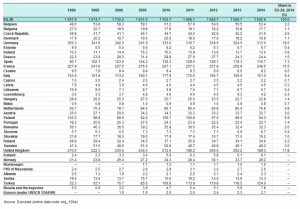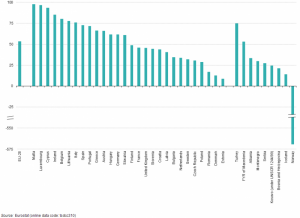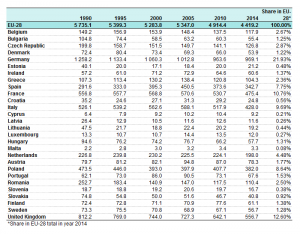ITRE II
Contents
- 1 'Timing matters: What measures should the EU take in order to increase energy efficiency from production to consumption and across sectors?'
'Timing matters: What measures should the EU take in order to increase energy efficiency from production to consumption and across sectors?'
Optimising energy efficiency is one of the top priorities of the EU’s Energy policy. The Union is currently facing issues with energy wastage, dependency on foreign imports and has set goals for lowering energy consumption by 20% (of that in 2007) by the year 2020. Increasing energy efficiency from the very first step of production down to the commercial consumer is a matter which can yield multi-faceted benefits: it can reduce the amount of environmental degradation which results from energy production, decrease electricity costs and energy dependency from countries outside the Union, as well as make the EU energy market more competitive. Thus, with the development of new, environmentally friendly technologies, it is of the utmost importance to underline key steps towards the ideal Energy Union - from production to consumption.
Relevance
Energy efficiency is of the utmost importance in the EU , seeing as environmental degradation is a serious threat to the future of the planet. In light of Article 194 of the Treaty of the Functioning of the European Union, the EU continuously aims to provide:
- ‘security of energy supply in the Union’,
- ‘promote energy efficiency and the development of new and renewable forms of energy’
- ‘promote the interconnection of energy networks’[1].
With environmental protection and energy policy being such a fundamental goal of the Union, it is high time we ensured the efficiency of the energy sector, in production, transportation and consumption.
Energy consumption: facts and stats

Fortunately, with energy production moving towards more sustainable sources, consumption in EU households seems to also be decreasing, albeit rather slowly. Energy consumption in households in the EU fell by 1.3%, as explained by Eurostat[2]. Sadly, this decrease is not equally distributed amongst MS, with a majority actually experiencing an increase in their electricity consumption (although mostly by less than 10%). Energy conservation efforts (such as the installation of energy conservation equipment) may play a part in this overall decrease; although it is speculated that it is mostly linked to demographic changes. It is, however, tantamount to ensure that energy consumption is further reduced in households, where possible, utilising environmentally friendly technologies.
Energy production: facts and stats
Energy in the EU is produced through a multitude of sources, chiefly combustible fuels and nuclear power plants, making up 47,6 and 27,4 per cent of energy production in the Union, respectively[3] . In recent years, however, the importance of renewable energy sources has increased, as highlighted by Eurostat reporting a massive increase of solar and wind power production from 0.02% in 2004 to 3.2%[4] of the net electricity production of the EU by 2014. Surprisingly, renewable energy sources was the only one that experienced such a uniform growth, from 2004 to 2014. Of course, there is a long way to go until our energy production becomes more environmentally friendly, sustainable, and of course, efficiently utilises our natural resources.
What is perhaps concerning, is that primary production in the EU has experienced a slump in the years from 2010 to 2014, which does not correspond to a similar drop in demand, with energy production being 17.3 % lower in 2014, than it was in 2004 .
Main issues, opportunities and challenges:
Challenges
Dependency on foreign imports

One of the greatest challenges the EU faces in terms of its energy sector, is how greatly dependent it is on foreign imports. Eurostat records that since 2004, energy imports have been higher than the primary production of energy in the EU, meaning that the Union is overwhelmingly dependent on foreign countries to secure its energy sector. More specifically, foreign imports increased from less than 40% of gross energy consumption in the 1980s to 53.5% in 2014. The highest energy dependency recorded was for crude oil, at 88.2% and natural gas, at 67.4%[5].
Energy dependency is also varied across MS, from Estonia, Denmark, Romania and Poland depending on foreign imports for less than 30% of their gross domestic energy consumption, to Luxembourg, Malta and Cyprus, recording an over 90% dependency on foreign imports. The reasons for this disparity, are the very differing natural resources in different MS, as well as the lack of development and competitiveness of the energy sector of many of these MS. What is also worrying is that there is no MS in the EU which actively engages in energy exports. Denmark used to be the only exporter, until 2013, when the country also began importing energy. This creates a great problem for the Union, which seems to have no surplus energy, and even worse, often cannot hold its own when it comes to satisfying energy demand with its own primary production.
Uneven supply and demand
An unfortunate drawback of renewable energy sources is the uneven supply and demand of electricity. The demand for electricity fluctuates throughout the day[6], as well as throughout the year, and with renewable sources being used, so does supply - with solar panels, for example producing energy only during the day, and a much greater volume during the warmer months). Thus, it is important to balance the grid and match supply to demand, meaning that either renewable power stations must limit their production during times of low demand, or that energy is not consumed and eventually wasted. Uneven supply and demand can also affect the EU regionally, as the energy needs of each country may vary greatly, due to such things as: time differences and seasonal requirements (air-conditioning/heating)[7].
Environmental concerns

The most obvious drawback of energy production of all, is of course, environmental degradation. Only less than one-fifth of the overall energy production of the Union is derived from renewable energy sources, meaning that for the rest, the EU is utilising fossil fuels or nuclear energy, leading to destructive consequences on the environment.
In 2014, Eurostat reported that the EU, as a whole emitted 4 419.2 million tonnes of greenhouse gases into the atmosphere , as the result of energy production from non-renewable sources. Despite this figure being 22.9% lower than the amount released in 1990[8] environmental damage caused by the release of such a large amount of CO2 and other greenhouse gases into the atmosphere, can have devastating effects on the environment.
Another way in which energy production can harm the environment is through the improper disposal of radioactive waste: a by-product of nuclear energy production. However, nuclear energy does not only pose a threat to the environment due to its by-products and their possible mis-handling, but also due to the high risk it bears, should a reactor be left unattended. For this reason, Germany has sworn off using nuclear energy, whilst two reactors in Belgium have been shut down, after the discovery of cracks in the reactors.[9]
Monopolies and weak energy market
Another major issue faced by the Union, in terms of energy production is the lack of market liberalisation in terms of electricity production in many Member States. For example, in small States such as Cyprus or Malta, the largest power generator held 100% of the market share for electricity in 2014, according to Eurostat[10]. This is an area of concern for the issue of energy efficiency, as it means that the production of electricity in the country is subject to limited or no investment in the free market, potentially hindering the sector’s growth.
OPPORTUNITIES
Better infrastructure
Energy sharing between MS
In order to be able to match demand to supply in power and ensure that countries are safeguarded and can guarantee energy to their citizens even in the case of a spontaneous halt in the use of imported fossil fuels, it is tantamount for MS to co-operate with each other and invest in infrastructure which will allow energy to flow freely and efficiently throughout the EU. In this way, the vision of the Energy Union is achieved and the existence of ‘energy islands’ throughout the Union is addressed.
The European Council set a 10% interconnection target to be completed by 2020, which the Commission believes should be extended to 15% by 2030[11] Investment in such cross-border connective infrastructure is a key step in ensuring stable energy supply and prevent wastage.
Smart Grids
https://www.smartgrid.gov/video/smart_grid.mp4 Smart grids are the latest technology in the energy sector. The current grid system present in most MS is considered outdated, as it allows only a one-way flow of electricity from production stations and storing facilities to the consumers. However, the smart grid establishes a two-way communication line, involving the consumers, production facilities and storage facilities, in order to balance the demand and supply of energy more effectively. As part of smart grids, the energy demands of the country are measured and recorded, and energy is better distributed to consumers.
Specifically, digital meters allow consumers to have in-depth information on their energy consumption, PMUs allow processors to assess grid stability, thus preventing malfunctions, automated feeder switches can reroute energy traffic around any possible problems in the system, whilst batteries are able to store excess energy produced during hours of low demand and re-supply it to the system when demand rises.[12]
Policy already in place/being discussed
2030 Framework for Climate and Energy
European Energy Security Strategy
Energy Union
Energy Efficiency Directive
Sum up
To sum up, the energy market in the European Union is a booming sector, which however, is undergoing major changes in recent years and still has a long way to go until it is sufficiently efficient. Indeed, with the EU so majorly emphasising the importance of a well-integrated Energy Union, pushing for a shift to renewable energy sources and calling for energy conservation at every level, it is time to look into the concrete measures that are required in order to reach the ambitious goals set forth in the 2030 Agenda, achieve de-carbonisation by 2050, but most importantly: ensure that energy production in the Union is as effective and as efficient as possible.
Sources/Further Research
- ↑ http://www.lisbon-treaty.org/wcm/the-lisbon-treaty/treaty-on-the-functioning-of-the-european-union-and-comments/part-3-union-policies-and-internal-actions/title-xxi-energy/485-article-194.html
- ↑ http://ec.europa.eu/eurostat/statistics-explained/index.php/Consumption_of_energy
- ↑ http://ec.europa.eu/eurostat/statistics-explained/index.php/Electricity_production,_consumption_and_market_overview
- ↑ http://ec.europa.eu/eurostat/statistics-explained/index.php/Electricity_production,_consumption_and_market_overview
- ↑ http://ec.europa.eu/eurostat/statistics-explained/index.php/Energy_production_and_imports
- ↑ https://www.eia.gov/todayinenergy/detail.php?id=830
- ↑ https://www.eia.gov/todayinenergy/detail.php?id=4190
- ↑ http://ec.europa.eu/eurostat/statistics-explained/index.php/Greenhouse_gas_emission_statistics
- ↑ http://www.europarl.europa.eu/atyourservice/en/displayFtu.html?ftuId=FTU_5.7.5.html
- ↑ http://ec.europa.eu/eurostat/statistics-explained/index.php/Electricity_production,_consumption_and_market_overview
- ↑ http://www.europarl.europa.eu/legislative-train/theme-resilient-energy-union-with-a-climate-change-policy/file-15-electricity-interconnection-target
- ↑ https://energy.gov/oe/services/technology-development/smart-grid